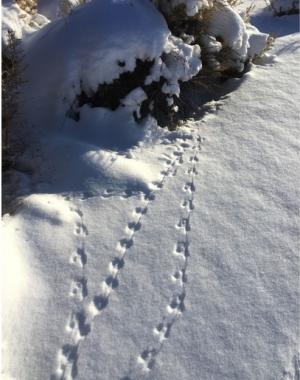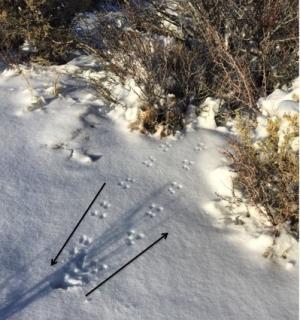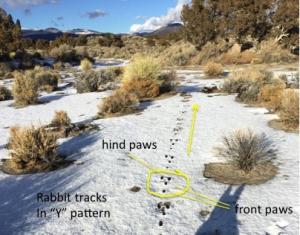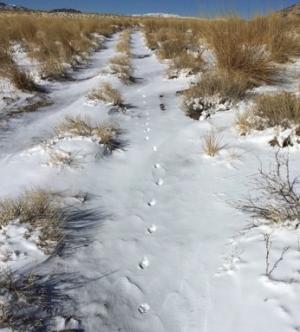What Fresh Tracks Reveal
Animals adapt to winter by either leaving the area (i.e. migrating) like deer and many birds; or they stay, but sleep most of the time (i.e. hibernating) like marmots and chipmunks; or they are active and running about looking for food. Those are the animals whose tracks we can see in the snow. Here in the Eastern Sierra snow country we can see the tracks of deer mice, kangaroo rats, voles, jackrabbits, cottontails, pygmy rabbits, weasels, pine martens, chickories, coyotes and the occasional wing impression of a raptor that spotted a rodent out in the open and dove for it. It is harder to see their tracks in the summer, but the snow vividly shows what lives here year-round. Some trails just stop, but looking closely, you may see a very small hole at the end of that track—leading to a tunnel in only 4-5 inches of snow!
 Kangaroo rats are bipedal, usually hopping on their two back feet. Their tracks look like stitches in the snow and the line in between is the tail drag.
Kangaroo rats are bipedal, usually hopping on their two back feet. Their tracks look like stitches in the snow and the line in between is the tail drag.


deer mouse tracks in snow to/from a hole hopper-style tracks
Rabbits, squirrels, and mice are hoppers. Hoppers place their front paws down and then swing their hind legs in front so they land in front of the front paws. The front paws are closer together than the hind paws. Mouse trails usually go from bush to bush and are small. The squirrels that are out and about in winter in our forests are Chickories (a Douglas tree squirrel). Their tracks will be bigger and will go from tree to tree. Rabbits may have tracks in the same pattern as squirrels and mice, but more often they make a "Y" pattern because they will place on front paw in front of the other and then swing their hind legs over in front of their front paws.


Rabbit tracks make a "Y" pattern coyote tracks will usually be in a line
Deer mice, voles, and weasels live and travel in tunnels under the snow (subnivean) to prevent heat loss and to hide from predators. That is why it is important that there is at least 18" of snow on the ground before snowmobiles and over-the-snow vehicles are allowed off-road.
One of the loveliest ways to see tracks is on cross-country skis or snowshoes. The Range of Light Group has restored the historic Blue Diamond cross-country ski routes at Obsidian Dome, the Inyo Craters, and Earthquake Dome. These are ungroomed routes that allow you to better see the winter world. Just grab a map at the USFS Visitor Center in Mammoth Lakes and follow the big turquoise diamonds on the trees! It will feel like a treasure hunt and you’re sure to see some treasures of the natural world out there! Link to ROLG's Blue Diamond map